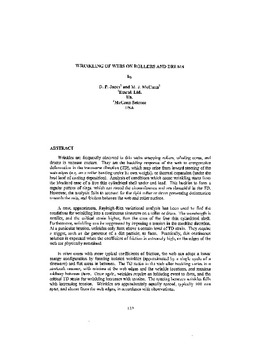| dc.contributor.author | Jones, D. P. | |
| dc.contributor.author | McCann, M. J. | |
| dc.contributor.other | International Conference on Web Handling (2005) | |
| dc.date.accessioned | 2019-11-08T22:56:48Z | |
| dc.date.available | 2019-11-08T22:56:48Z | |
| dc.date.issued | 2005-06 | |
| dc.identifier | oksd_icwh_2005_jones | |
| dc.identifier.citation | Jones, D. P., & McCann, M. J. (2005, June). Wrinkling of webs on rollers and drums. Paper presented at the Eighth International Conference on Web Handling (IWEB), Stillwater, OK. | |
| dc.identifier.uri | https://hdl.handle.net/11244/321880 | |
| dc.description.abstract | Wrinkles are frequently observed in thin webs wrapping rollers, winding cores, and drums in vacuum coaters. They are the buckling response of the web to compressive deformation in the transverse direction (TD), which may arise from inward steering of the web edges (e.g. on a roller bending under its own weight), or thermal expansion (under the heat load of coating deposition), Analysis of conditions which cause wrinkling starts from the idealised case of a free thin cylindrical shell under end load. This buckles to form a regular pattern of rings, which run round the circumference and are sinusoidal in the TD. However, the analysis fails to account for the rigid roller or drum preventing deformation towards the axis, and friction between the web and roller surface. | |
| dc.description.abstract | A new, approximate, Rayleigh-Ritz variational analysis has been used to find the conditions for wrinkling into a continuous sinewave on a roller or drum. The wavelength is smaller, and the critical strain higher, than the case of the free thin cylindrical shell. Furthermore, wrinkling can be suppressed by imposing a tension in the machine direction. At a particular tension, wrinkles only form above a certain level of TD strain. They require a trigger, such as the presence of a dirt particle, to form. Practically, this continuous solution is expected when the coefficient of friction is extremely high, or the edges of the web are physically restrained. | |
| dc.description.abstract | In other cases with more typical coefficients of friction, the web can adopt a lower energy configuration by forming isolated wrinkles (approximated by a single cycle of a sinewave) and flat areas in between, The TD strain in the web after buckling varies in a sawtooth manner, with minima at the web edges and the wrinkle locations, and maxima midway between them. Once again, wrinkles require an initiating event to form, and the critical TD strain for wrinkling increases with tension. The spacing between wrinkles falls with increasing tension. Wrinkles are approximately equally spaced, typically 100 mm apart, and absent from the web edges, in accordance with observations. | |
| dc.format | application/pdf | |
| dc.language | en_US | |
| dc.publisher | Oklahoma State University | |
| dc.rights | In the Oklahoma State University Library's institutional repository this paper is made available through the open access principles and the terms of agreement/consent between the author(s) and the publisher. The permission policy on the use, reproduction or distribution of the article falls under fair use for educational, scholarship, and research purposes. Contact Digital Resources and Discovery Services at lib-dls@okstate.edu or 405-744-9161 for further information. | |
| dc.title | Wrinkling of webs on rollers and drums | |
| osu.filename | oksd_icwh_2005_jones.pdf | |
| dc.type.genre | Conference proceedings | |
| dc.type.material | Text | |
